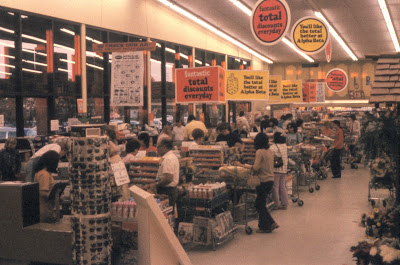Here’s a wonderful set of photos featuring two stores from one of Southern California’s most fondly remembered supermarket chains – the late, lamented Alpha Beta. The photos were taken in the early 70’s by Werner Weiss, webmaster of the Yesterland website, a superb tribute to the early years of Disneyland. Yesterland, one of the most celebrated and influential nostalgia sites on the web, marked its 20th anniversary online last year. Though Alpha Beta had stores all over SoCal (and several in other regions as well), these were both located in “The O.C.” – Orange County, Alpha Beta’s home turf.
What can you say about the store in the first photo, other
than it was a stone cold 1950’s classic? Opened in June, 1958 in the Hillview
section of Santa Ana, at 17th Street and Tustin Avenue, this store,
with its massive pylon and iconic “Alphy” sign, perfectly exuded the optimism,
excitement and humor of the “anything is possible” postwar Southern California.
The store didn’t seem much worse for wear sixteen years later, in 1974, when this
photo was shot, but you’d have to think it looked more natural with a parking
lot full of tailfins.
The rest of the photos are interior shots from the Alpha
Beta store in Huntington Beach, at the corner of Brookhurst Street and Hamilton
Avenue. I haven’t been able to verify the exact opening year of this store
(Alpha Beta’s “No. 126”), but according to Werner, who worked there in college
and took these photos in the fall of 1972, it was a new store then. The store
sports the “ranch style” roofline that Alpha Beta had favored since the
mid-sixties.
What strikes me the most about these photos, even the one of
the older store, is how reflective the scenes are of 1972-74 American life, due
to the overwhelming presence of one word - “discount” – plastered all over the
interior of the store, and in huge letters across the storefront windows.
These were the years when new words and phrases began to
creep their way into dinner table conversations across the country: “inflation”,
“cost of living” and “Consumer Price Index”, for example, because these things
were directly affecting what was on the
dinner table. It was an era of rampant, unprecedented inflation, when consumer
dollars seemed to shrink by the week. Despite some fairly extreme governmental
steps taken to stem the tide (a wage-price freeze, dollar devaluation, etc.),
it continued for years.
The scene that evokes this strongest for me personally is in
the fifth photo down, the “new ideas” display, with boxes of Tuna Helper, in
three glorious flavors, clearly visible on the second shelf. My family ate so
much of this stuff (and its sister meal enhancer, Hamburger Helper) in those
years that I still feel General Mills should have awarded us a walnut plaque
with a golden Betty Crocker spoon mounted to it.
In response to the situation, the major supermarket chains, including such
Western-based heavyweights as Safeway, welterweights such as Albertsons, and
more regionalized operations like Alpha Beta (then a division of a middleweight,
Philly-based Acme Markets) practically fell over themselves trying to attach
the word “discount” to their storied names. Certainly this was a national
trend, however, with appended names galore - Acme “Super Saver” stores, Food
Fair’s accelerated conversion to “Pantry Pride Discount Foods”, and numerous
others. Then there was A&P’s disastrous WEO (“Where Economy Originates”)
program, but that’s a saga unto itself.
But there had been a precedent for this not that many years
before, however. The early 70’s weren’t the first time the major food chains were
forced to respond to an economic pinch. There was a dry run of sorts in the
fall of 1966, when consumer complaints about supermarket pricing galvanized
into a national movement, with boycotts occurring at stores across the country.
Numerous press photos exist of bouffanted housewives carrying protest signs, a
scene that led some in the press to coin the unfortunate term “girlcott” (Ugh.)
to describe the situation.
The 1966 boycotts were short-lived, but in their aftermath,
a number of chains experimented with standalone discount formats. Alpha Beta
was one of them, with their experimental “Fad” (“food at discount” – nifty, right?)
stores. Concerned about price competitiveness but unwilling to risk the Alpha
Beta name on a discount venture, the first Fad store, a converted Alpha Beta
unit, was opened in Costa Mesa in April 1967.
The location was chosen for its very close proximity to
another Alpha Beta store, allowing the company to compare shopping patterns at
the two stores and to answer the following questions, as outlined in Esther
Cramer’s great book The Alpha Beta Story: “Would the housewife change her
shopping habits if operating hours were reduced and games and giveaways were
eliminated? Would the volume of sales increase to the necessary level if prices
were lowered?” The answers, as it turned out, were “yes”.
As a result, three additional Fad stores were opened that
year, followed by yet three more in 1968. Most importantly, it led to a change
in pricing policy for the main Alpha Beta stores, which was rolled out in two
phases – discounting of all health and beauty items effective in September 1967,
and discounting across the entire store effective New Year’s Day 1968. Trading
stamps and other promotional gimmicks were dropped, and even the famous tagline
on their signs was changed, from “First in Foods” to “Best for Less”. In September 1971, having applied the lessons
learned, the Fad name was discontinued and the (by then 11) Fad stores were
converted to garden variety Alpha Betas.
So bargain-based grocery shopping turned out to be anything
but a fad.






